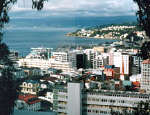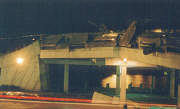Welcome to the first monthly article about Wellington, the capital of New Zealand. In later months I’ll explore some of the sights and sounds, the culture and the people which make this city a great place to visit and to live.
But for a start I thought I’d just fill you in on a few basic facts and a little history.
|
![]()
Wellington sits on the shores of a vast, nearly circular harbour, enclosed on all sides by hills and mountain ranges. At the bottom end of the North Island, the region sticks out into the Southern Ocean, the reason for it’s famously windy weather.
Greater Wellington has a population of some 400,000 people, but this figure includes the satellite cities of Porirua and Hutt Valley. The central city, including the House of Parliament, the central business district and inner city suburbs perch on mostly reclaimed land around Lambton Harbour and Te Aro foreshore.
Wellington is also the arts and culture capital of the country. It is the home of the New Zealand Symphony Orchestra, the National Ballet company and Te Papa, the national museum. The city frequently plays host to international cultural events and festivals. The Edinburgh Tattoo was held here in January, the first time it had played outside Scotland.
There are over three hundred cafes and restaurants in Wellington, offering cuisine from around the world, and the night life rivals any large cosmopolitan city.
Art lovers will be well catered for. Several large public galleries, including Te Papa and the City gallery offer world ranking exhibitions, and local artists can be seen in numerous small galleries, cafes and in public works of sculpture.
History
|
![]()
It’s a bustling metropolis now, and some say the most exciting city in New Zealand, but it wasn’t always like this. In fact, just over 150 years ago this beautiful harbour was barely populated at all. There were small Maori villages in the valleys of Te Aro and Petone, but the rest of what is now Wellington was virgin bush and coastal river plains.
By world standards Wellington is a very young city. It was founded by the New Zealand company in 1839 as the first official British settlement in New Zealand. On 20 September that year, the barque Tory arrived, carrying surveyors and settlers from England, led by Colonel William Wakefield. They built settlements on the Lambton foreshore, and by the mouth of the Hutt river at Petone.
Captain James Cook, the famous British explorer, anchored in the Resolution a mile from the entrance of Wellington harbour in 1773, but didn’t push past the narrow channel to discover the great body of sheltered water beyond. Fifty years had to go by before the first European visit, when Captain Herd sailed the Lambton into what he called Port Nicholson.
But the first person to see this great harbour was the Polynesian explorer Kupe, who sailed to New Zealand from Hawaiki, the legendary Pacific homeland. Historians differ on when Kupe’s voyage was made, 900AD seems about the best estimate.
Two centuries or so later the ancestors of the Maori arrived in the area around Wellington. A chief called Whatonga, who had settled in Hawkes Bay, sent his son Tara and his half brother Tautoki on a year long expedition to explore the southern half of the North Island. They reported fertile land around a sheltered harbour, and as a result of these reports, Whatonga and his people came and settled here, founding Ngati Tara, the tribe of Tara. The harbour they named Te Whanganui a Tara, the great harbour of Tara.
Since early times Wellington has offered safe anchorage to travellers in the Southern seas. Herd, the European discoverer of the harbour described it as a place where "all the navies of Europe might ride in perfect security."
Nowadays it’s an exciting, beautiful city. The people here are friendly and welcoming. There is heaps to do, from sipping a latte in a cafe on Cuba St, to mountain biking in the green belt, to visiting the seal colony at Red Rocks.
Come back next month, and we’ll explore this place in more detail together.
The capital city of New Zealand, Wellington is situated at the southern end of the North Island. Just over 400,000 people live in Wellington and it’s satellite cities in Porirua and the Hutt Valley.
Wellington hosts the seat of central Government in New Zealand.
Transport
The international airport at Rongotai accepts flights from Sydney, Melbourne and Perth, but if you’re coming from further away you’ll have to catch a link flight from Auckland or Christchurch. The surrounding mountains prevent aircraft larger than a 767 from landing here.
The airport is a ten minute drive from downtown, with regular bus services running every half hour. Or you can call the airport shuttle on 61-4-388-8900.
Accommodation
Central Wellington has a plethora of hotels, backpackers and apartment hotels to suit all tastes and budgets. The Plaza International and the Park Royal, both in the central city, offer the highest international standards of service, while Trekkers in Cuba St and Rosemere Backpackers offer less expensive accommodation.
For more information on where to stay in Wellington, see the Wellington Accommodation Database.
What’s On
There is always something entertaining happening in Wellington. Any night of the week you can catch a play or a performance, eat at any of three hundred cafes and restaurants, or catch an exhibition of international and local artists.
For a fairly comprehensive list of events, news and reviews, and features about Wellington, check out The Package.
Other good Wellington Web directories:
Wellington W4
Search Wellington
Money
100 cents = 1 dollar. New Zealand dollars are not worth much, so you get great value for your exchange.
Currently buying at:
$US = NZ$2.1598
Sterling = £3.2758
$AUS = $1.2667
$CAN = $1.4678
EURO = 2.0179
The Author
Malcolm Hutchinson makes his living as a freelance writer, mostly in the information technology industry. He has been living in Wellington for two years now, and loves it all, for the culture, the beauty of the city and the proximity to the South Island national parks. He’s a keen tramper, and is trying to turn himself into a mountaineer.
You can email Malcolm, or check out his website if you want to know more.

